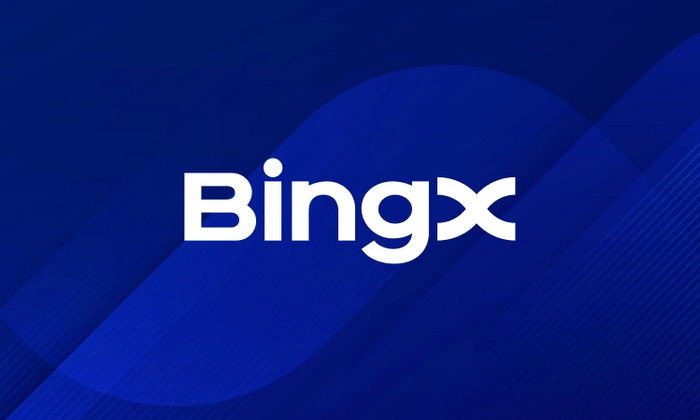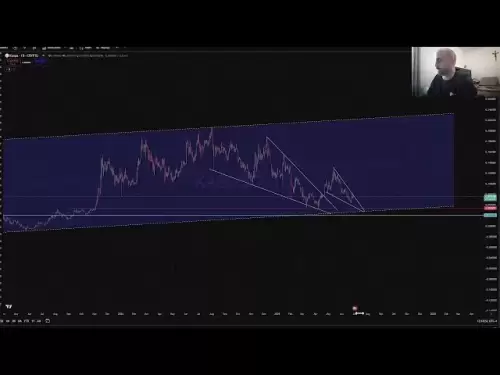-
 Bitcoin
Bitcoin $107,341.7259
0.15% -
 Ethereum
Ethereum $2,438.6204
0.70% -
 Tether USDt
Tether USDt $1.0003
-0.02% -
 XRP
XRP $2.1866
1.94% -
 BNB
BNB $649.0952
0.36% -
 Solana
Solana $150.9602
5.63% -
 USDC
USDC $0.9999
0.00% -
 TRON
TRON $0.2742
0.40% -
 Dogecoin
Dogecoin $0.1645
1.93% -
 Cardano
Cardano $0.5669
1.18% -
 Hyperliquid
Hyperliquid $37.8286
4.19% -
 Bitcoin Cash
Bitcoin Cash $491.4669
-2.74% -
 Sui
Sui $2.8150
3.06% -
 Chainlink
Chainlink $13.4184
2.91% -
 UNUS SED LEO
UNUS SED LEO $9.0809
0.27% -
 Avalanche
Avalanche $18.0295
2.60% -
 Stellar
Stellar $0.2396
1.19% -
 Toncoin
Toncoin $2.8587
0.13% -
 Shiba Inu
Shiba Inu $0.0...01160
2.59% -
 Litecoin
Litecoin $86.4192
1.45% -
 Hedera
Hedera $0.1486
1.19% -
 Monero
Monero $308.4324
0.87% -
 Polkadot
Polkadot $3.4202
1.43% -
 Bitget Token
Bitget Token $4.6436
-0.34% -
 Dai
Dai $0.9998
-0.02% -
 Ethena USDe
Ethena USDe $1.0002
0.00% -
 Uniswap
Uniswap $7.1527
3.29% -
 Pi
Pi $0.5357
-8.45% -
 Pepe
Pepe $0.0...09588
4.61% -
 Aave
Aave $259.9759
0.81%
How to calculate BingX contract margin
Understanding margin calculations is essential for effective risk management in crypto trading platforms like BingX.
Nov 25, 2024 at 11:10 am

How to Calculate BingX Contract Margin
In the realm of cryptocurrency trading, understanding contract margin is crucial for effective risk management. BingX, a renowned crypto exchange, provides a comprehensive margin trading platform that enables traders to leverage their positions and amplify their potential profits. This article delves into the intricacies of calculating BingX contract margin, providing a step-by-step guide to empower traders with the knowledge to navigate this dynamic aspect of crypto trading.
Step 1: Understanding Contract Margin
Contract margin refers to the collateral required by an exchange to initiate and maintain leveraged positions. It serves as a buffer against potential losses, ensuring that traders have sufficient funds to cover adverse market movements. BingX employs an initial margin and maintenance margin system to safeguard against excessive risk-taking.
The initial margin represents the minimum amount of funds required to open a position, while the maintenance margin is the threshold that must be maintained to avoid liquidation. Failure to meet the maintenance margin requirement can lead to automatic closure of the position, resulting in potential losses.
Step 2: Determining Initial Margin
The initial margin calculation varies depending on the specific contract and leverage applied. BingX typically displays the initial margin as a percentage of the contract value. For example, if a trader wishes to open a long position on the BTCUSDT perpetual contract with 10x leverage, the initial margin would be calculated as follows:
Initial Margin = Contract Value Initial Margin Percentage Leverage
Assuming the contract value is $10,000, the initial margin percentage is 5%, and the leverage is 10x, we get:
Initial Margin = $10,000 * 5% * 10 = $500
Therefore, the trader would need $500 in their margin account to open the position.
Step 3: Adjusting for Dynamic Margin
BingX employs a dynamic margin system that adjusts the initial margin requirements based on market volatility. When volatility increases, the exchange may increase the initial margin to mitigate risks. Conversely, during periods of low volatility, the initial margin may be reduced.
Traders should regularly monitor the BingX announcement channel for any updates or changes to the dynamic margin requirements. Failure to adjust positions accordingly can lead to unexpected margin calls or liquidations.
Step 4: Monitoring Maintenance Margin
The maintenance margin is the crucial threshold that must be maintained to prevent liquidation. BingX typically sets the maintenance margin at a lower percentage than the initial margin, allowing traders some breathing room to manage their positions.
However, it's essential to monitor the maintenance margin closely, especially during volatile market conditions. If the account equity falls below the maintenance margin, the exchange may issue a margin call, requiring the trader to deposit additional funds or reduce their position size.
Step 5: Managing Risk with Stop-Loss Orders
Stop-loss orders are a valuable risk management tool that can help traders limit their potential losses. By placing a stop-loss order below the entry price, traders can automatically close their position if the market moves against them, preventing further losses beyond the predefined threshold.
BingX provides a comprehensive stop-loss order system that allows traders to customize their parameters, including the stop-loss price, execution mechanism, and order type. Traders should consider using stop-loss orders in conjunction with margin trading to enhance their risk management strategy.
Step 6: Understanding Liquidation
Liquidation occurs when the account equity falls below the maintenance margin and the trader fails to meet the margin call. The exchange will forcibly close the position, realizing any remaining value and using it to cover the outstanding margin.
Liquidation can result in significant losses, especially if the market moves rapidly against the trader's position. It's crucial to monitor positions closely, manage risk effectively, and be prepared to take corrective actions to avoid liquidation.
Step 7: Advanced Margin Management Techniques
BingX offers advanced margin management techniques, such as cross margin and isolated margin, to accommodate different trading strategies. Cross margin allows traders to share margin across multiple positions, while isolated margin limits the risk to individual positions.
Understanding these advanced techniques can enhance risk management and provide traders with greater flexibility in managing their margin accounts. However, it's essential to thoroughly research and comprehend these techniques before implementing them in live trading.
Step 8: Seeking Professional Advice
Cryptocurrency trading, especially involving leverage and margin, carries inherent risks. Traders are strongly advised to seek professional advice from experienced financial advisors or analysts before engaging in such activities. Proper risk assessment, financial planning, and continuous learning are vital to navigate the complexities of margin trading and maximize the potential for success.
Disclaimer:info@kdj.com
The information provided is not trading advice. kdj.com does not assume any responsibility for any investments made based on the information provided in this article. Cryptocurrencies are highly volatile and it is highly recommended that you invest with caution after thorough research!
If you believe that the content used on this website infringes your copyright, please contact us immediately (info@kdj.com) and we will delete it promptly.
- AI Token Taking Over: Why Smart Investors are Eyeing Audited Crypto Ruvi AI
- 2025-06-29 04:30:12
- Ethereum, AI Tokens, and Growth: Is Ruvi AI the Next Big Thing?
- 2025-06-29 04:30:12
- Hedera Price: Decoding Technical Signals and Upside Potential
- 2025-06-29 04:50:13
- Altcoin Rally on the Horizon? Decoding the Potential Boom
- 2025-06-29 04:35:12
- On-Chain Data Deep Dive: Altcoin Growth & Transaction Volume Insights
- 2025-06-29 05:30:13
- Cryptos, Real Growth, 2025: Navigating the Landscape
- 2025-06-29 05:30:13
Related knowledge

How to use the price slope to filter the false breakthrough signal of the contract?
Jun 20,2025 at 06:56pm
Understanding the Concept of Price Slope in Contract TradingIn contract trading, especially within cryptocurrency derivatives markets, price slope refers to the rate at which the price changes over a specific time period. It helps traders assess the strength and sustainability of a trend. A steep slope may indicate strong momentum, while a shallow slope...

How to determine the expected volatility of the contract through the volatility cone?
Jun 19,2025 at 12:28pm
Understanding the Basics of Volatility in Cryptocurrency ContractsIn the realm of cryptocurrency trading, volatility is a key metric that traders use to assess potential risk and reward. When dealing with futures contracts, understanding how volatile an asset might become over time is crucial for position sizing, risk management, and strategy developmen...

How to formulate a contract intraday trading plan in combination with the pivot point system?
Jun 21,2025 at 03:42pm
Understanding the Basics of Pivot Points in Cryptocurrency TradingPivot points are technical analysis tools used by traders to identify potential support and resistance levels. These levels are calculated using the previous day's high, low, and closing prices. In the context of cryptocurrency trading, where markets operate 24/7, pivot points help trader...

How to adjust the contract position ratio through the price fluctuation entropy?
Jun 22,2025 at 11:42am
Understanding Price Fluctuation Entropy in Cryptocurrency ContractsIn the world of cryptocurrency futures trading, price fluctuation entropy is a relatively new concept used to measure market volatility and uncertainty. It derives from information theory, where entropy refers to the degree of randomness or unpredictability in a system. In crypto contrac...

How to use the volume swing indicator to predict the contract volume-price divergence?
Jun 18,2025 at 11:42pm
Understanding the Volume Swing IndicatorThe volume swing indicator is a technical analysis tool used primarily in cryptocurrency trading to evaluate changes in volume over time. Unlike price-based indicators, this metric focuses solely on trading volume, which can provide early signals about potential market reversals or continuations. The key idea behi...

How to use the Gaussian channel to set the contract trend tracking stop loss?
Jun 18,2025 at 09:21pm
Understanding the Gaussian Channel in Cryptocurrency TradingThe Gaussian channel is a technical indicator used primarily in financial markets, including cryptocurrency trading, to identify trends and potential reversal points. It is based on statistical principles derived from the normal distribution, commonly known as the Gaussian distribution or bell ...

How to use the price slope to filter the false breakthrough signal of the contract?
Jun 20,2025 at 06:56pm
Understanding the Concept of Price Slope in Contract TradingIn contract trading, especially within cryptocurrency derivatives markets, price slope refers to the rate at which the price changes over a specific time period. It helps traders assess the strength and sustainability of a trend. A steep slope may indicate strong momentum, while a shallow slope...

How to determine the expected volatility of the contract through the volatility cone?
Jun 19,2025 at 12:28pm
Understanding the Basics of Volatility in Cryptocurrency ContractsIn the realm of cryptocurrency trading, volatility is a key metric that traders use to assess potential risk and reward. When dealing with futures contracts, understanding how volatile an asset might become over time is crucial for position sizing, risk management, and strategy developmen...

How to formulate a contract intraday trading plan in combination with the pivot point system?
Jun 21,2025 at 03:42pm
Understanding the Basics of Pivot Points in Cryptocurrency TradingPivot points are technical analysis tools used by traders to identify potential support and resistance levels. These levels are calculated using the previous day's high, low, and closing prices. In the context of cryptocurrency trading, where markets operate 24/7, pivot points help trader...

How to adjust the contract position ratio through the price fluctuation entropy?
Jun 22,2025 at 11:42am
Understanding Price Fluctuation Entropy in Cryptocurrency ContractsIn the world of cryptocurrency futures trading, price fluctuation entropy is a relatively new concept used to measure market volatility and uncertainty. It derives from information theory, where entropy refers to the degree of randomness or unpredictability in a system. In crypto contrac...

How to use the volume swing indicator to predict the contract volume-price divergence?
Jun 18,2025 at 11:42pm
Understanding the Volume Swing IndicatorThe volume swing indicator is a technical analysis tool used primarily in cryptocurrency trading to evaluate changes in volume over time. Unlike price-based indicators, this metric focuses solely on trading volume, which can provide early signals about potential market reversals or continuations. The key idea behi...

How to use the Gaussian channel to set the contract trend tracking stop loss?
Jun 18,2025 at 09:21pm
Understanding the Gaussian Channel in Cryptocurrency TradingThe Gaussian channel is a technical indicator used primarily in financial markets, including cryptocurrency trading, to identify trends and potential reversal points. It is based on statistical principles derived from the normal distribution, commonly known as the Gaussian distribution or bell ...
See all articles

























































































